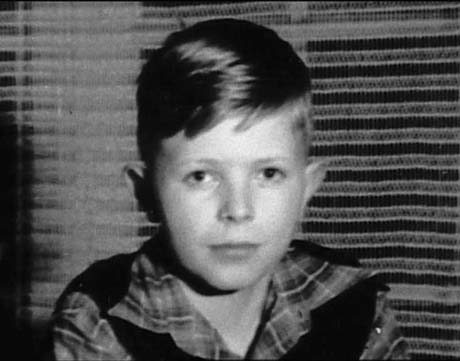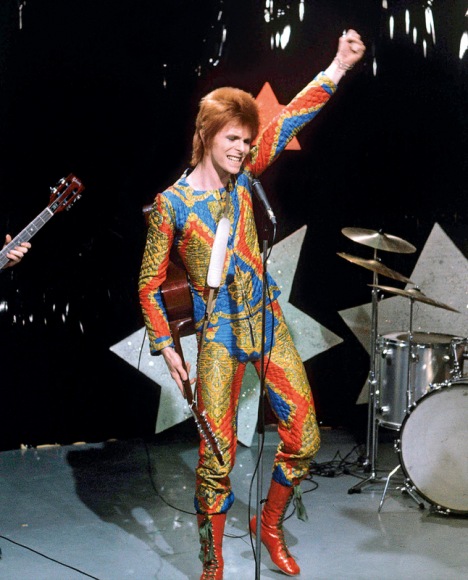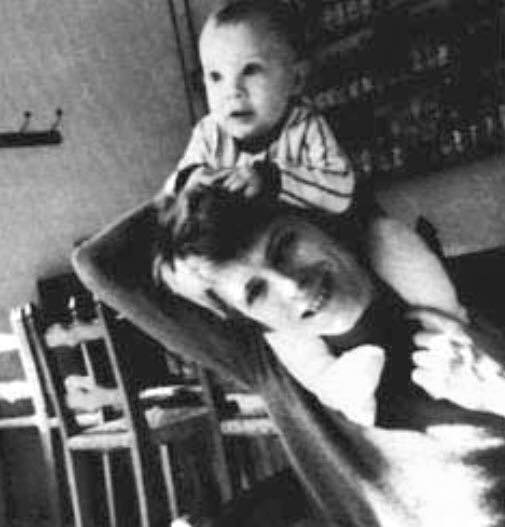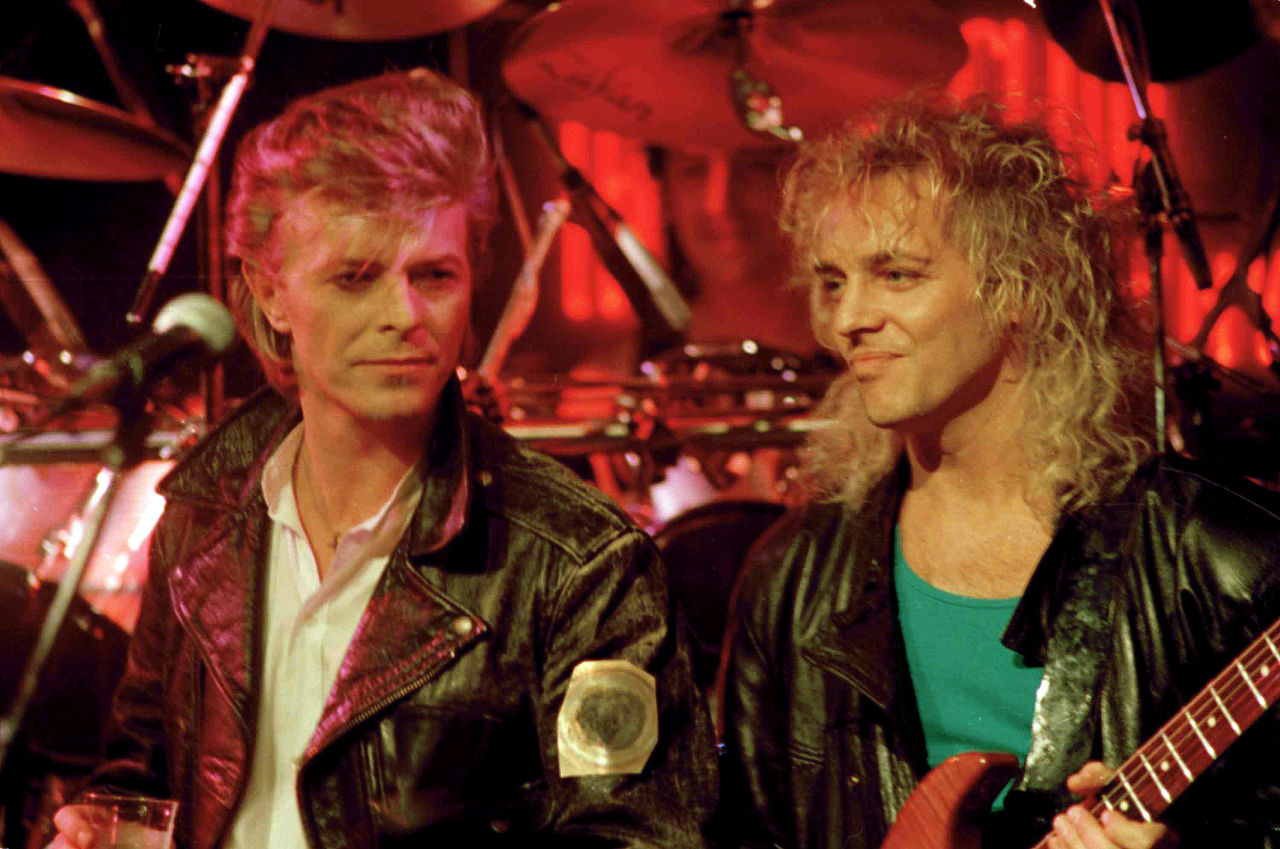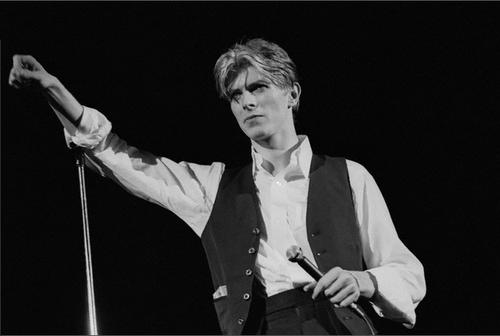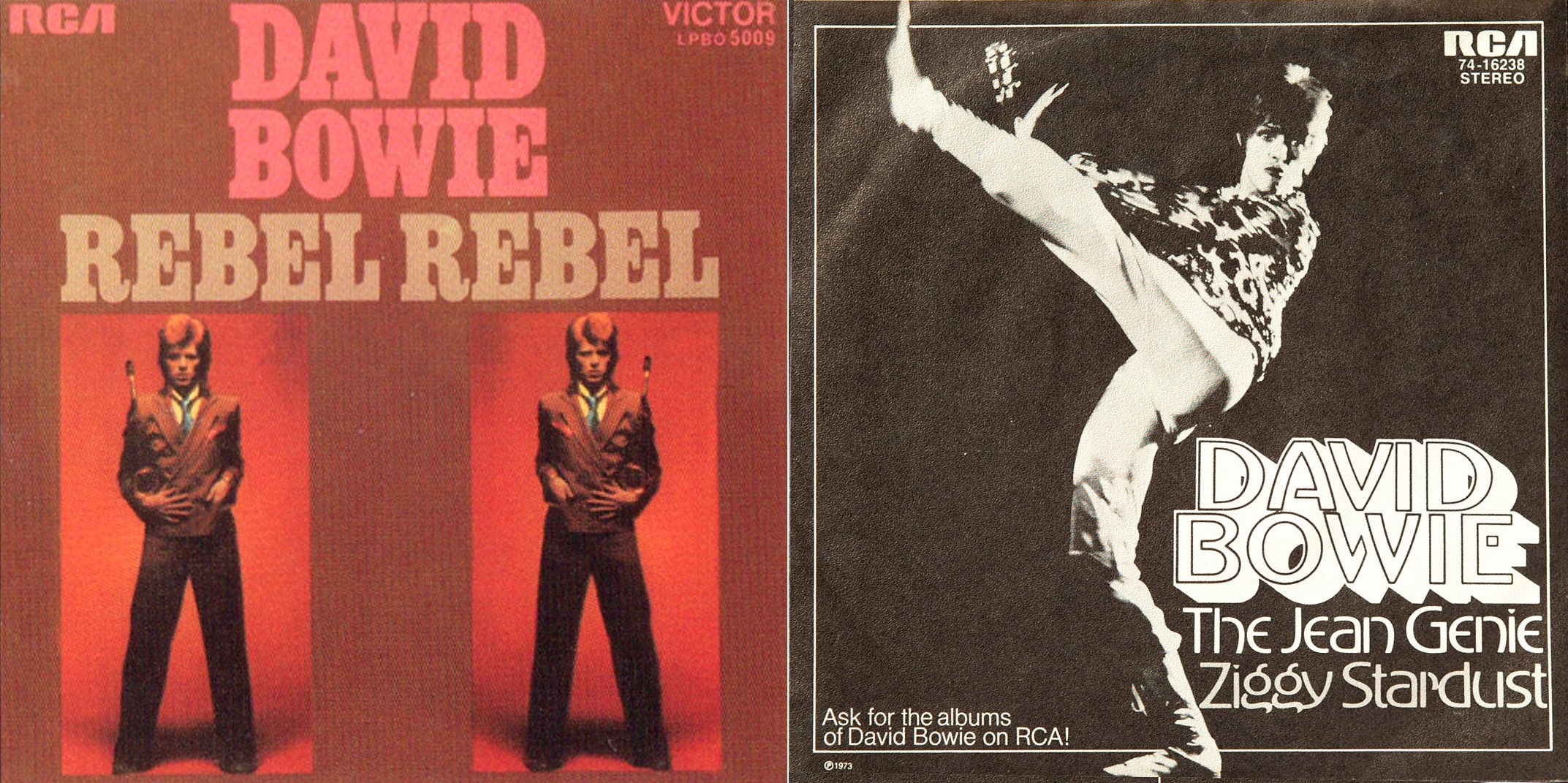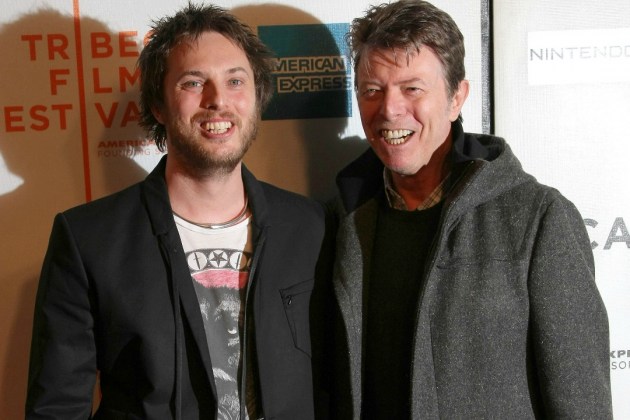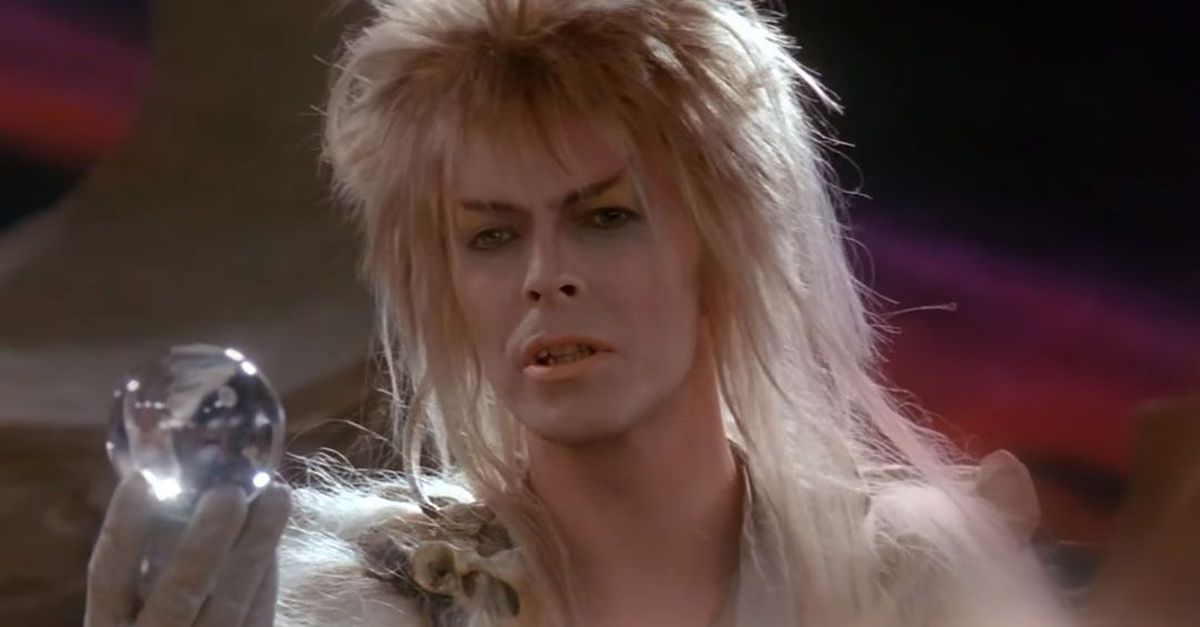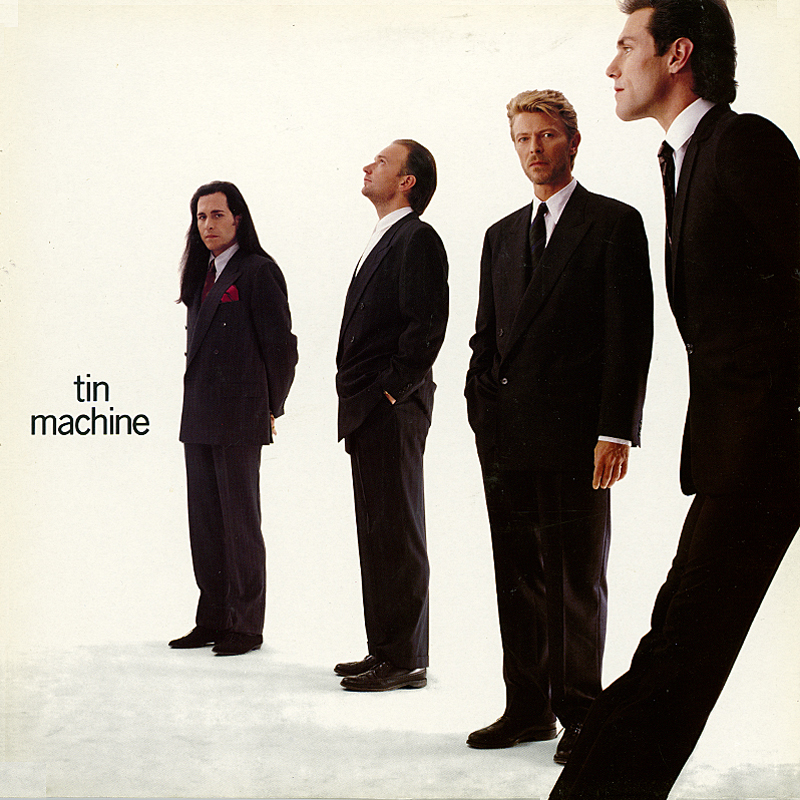
|
The 2016 Dead Man of the Year Award...
By J.C. Mašek III 

The Last Living Rock King is no more...
The 2016 Dead Man ... could only be... When I first heard that the great, great David Bowie had died, I was devastated. There was (and could be) only one rock and roll icon like him. He was Ziggy Stardust, he was The Thin White Duke, he was The Man Who Fell To Earth, he was Major Tom, he was Aladdin Sane and he was so much more. There was no question from the moment I heard he had passed that he would be the honoree of the 2016 DMOTY Sadly, 2016 was not done with us yet. More major icons died during that year than any other year in my memory. Carrie Fisher, Glenn Frey, Tony Burton, George Kennedy, George Martin, Keith Emerson, Alan Rickman, Patty Duke, Merle Haggard, Muhammad Ali, Gary Marshall, Kenny Baker, Jon Polito, Leonard Cohen, Leon Russell, Mose Allison, Richard Adams, George Michael and, painfully, Prince all left us this year amongst many, many others, too numerous to list. It is safe to say that 2016 was a terrible year for losing many of our best and any one of them deserve to be honored. In fact, this is the only year so far that the honoree and all nominees all died during the same year. However, there is still only ONE David Bowie and no matter how many others died this year, Bowie is still the main one we honor most today. David Robert Jones was born on Elvis' birthday, January the 8th, 1947 to Peggy and John Jones. From an early age the man who would be Spaceboy took to music. Although his voice in the choir was considered only "adequate" his abilities with playing music were extraordinary already. Also the boy could dance in a way that was described as "astonishing". Right around that time when he was introduced to Rock and Roll and his life changed forever. So would the face of music. Hearing singers like Elvis, Chuck Berry and Little Richard inspired Bowie to become a musician and he took on the piano, bass and ukulele. Even at a young age, he was called "mesmerizing". By the time he was fourteen years of age in 1961, Bowie was already experimenting with bands, including George and the Dragons and The Konrads, his first collaborations with George Underwood who had a direct impact on Bowie's visuals in more ways than one (see sidebar). This fascination with music continued on into high school where he studied art, music and design and played guitar. When a younger student named Peter Frampton began attending the school, the pair began playing guitar together in the stairwells. It would not be the last time they would jam (see sidebar). Once his older brother Terry introduced David to Jazz music, the young artist began playing saxophone and taking professional lessons. Determined to become a pop star, David left school at age sixteen and formed a new band with aspirations beyond those of the bands he had previously contributed to. Obtaining funding and management from Leslie Conn, a businessman and music publisher, David soon managed to get gigs with his newly formed band. "Davie Jones and the King Bees" was, in fact, the first band the man eventually to become David Bowie would record an album with and his debut single, "Liza Jane" was released on June 5, 1964, when young Master Jones was only seventeen years of age. One might expect that success was immediate, but the career of Davie Jones and the King Bees proved to be short lived and wrought with commercial failures. Frustrated by this and the frequent confusion with Davy Jones of The Monkeys, the young musician decided on a fresh start. Davie Jones became David Bowie (inspired by Jim Bowie, creator of the Bowie Knife). Thus the genius now had the beginnings of his persona, but not his stardom. His self-titled debut album (released in mid-1967) was not an immediate success and Bowie released nothing else for two full years. That is, no releases under any of his own names. To fill the time, David Bowie began taking dance classes, working on his image, studying drama and writing songs for other artists to release. He also dated and performed with Hermione Farthingale who would influence many of his early works including the short film Love You Till Tuesday, the song Life on Mars? and, of course, the song Letter to Hermione. It was another early composition that would become a big success for Bowie. "Space Oddity" is a psychedelic folk rock exploration of an ill-fated mission for one Major Tom, a character Bowie would revisit multiple times throughout his life. The single was also packaged on his 1969 second album, initially (and confusingly) also entitled David Bowie in the UK, it was released as Man of Words/Man of Music in the US and finally worldwide as Space Oddity. Before that trippy song became a hit, David Bowie met and quickly married Angela Barnett and collaborated with guitarists such as Marc Bolan and Mick Ronson. Soon a new band was formed with David Bowie as the frontman. Toying with the image that would one day define The Spiders from Mars, Bowie and the band soon were noticed for their music and their unique look. Capitalizing on this notoriety Mercury Records heavily promoted the new band and their album The Man Who Sold The World (1970). Noting that his androgynous appearance and occasional cross-dressing gained him great notice, the singer (again, married to a woman) played up the idea that he might actually be gay for the publicity. It worked. The successful tour gained Bowie international fans and exposure to other artists. Meeting both Lou Reed of The Velvet Underground and Iggy Pop of The Stooges, David Bowie decided to meld their two personalities and personas into one fictional character who would become "The Ultimate Pop Idol" who "looks like he's landed from Mars". It is no accident that "Ziggy" rhymes with "Iggy" and the surname was borrowed from Norman Carl Odam aka "The Legendary Stardust Cowboy". Eventually David Bowie would perform as "Ziggy Stardust" and his backing band became "The Spiders from Mars", but there were other steps to take before the character was fully formed. Arguably the biggest change in Bowie's life and personality took place offstage with the birth of his best friend in the world. Zowie Bowie was born to David and Angela Bowie on May 30, 1971 and he would be known by the name "Zowie Bowie" for the first twelve years of his life (though his legal birth name was and remains Duncan Zowie Haywood Jones). The next album Hunky Dory (1971) featured a song, "Kooks", which was written for the young Zowie along with a cornucopia of other songs on various subjects in various styles. Although the album was not a major hit at the time, Bowie's successes were just about to become huge. Bowie's new alter ego was soon ready for his debut. Ziggy Stardust and the Spiders from Mars had their first appearance on stage in London on February 10, 1972. The new stage show was an immediate success and thrust Bowie from nascent career musician just on the verge of greatness to absolute super-stardom. "Stardust" became a breakthrough single for Bowie and the band and the album that followed, The Rise and Fall of Ziggy Stardust and the Spiders from Mars (June 16, 1972) remains an enormous landmark in rock and roll music. Audiences formed a "Cult of Bowie" and his previous releases like Hunky Dory, The Man Who Sold The World and Space Oddity were rediscovered and became hits for Bowie, helping to catapult him further into stardom. "John, I'm Only Dancing", a non-album single, and "All The Young Dudes" (which fits in with the Ziggy Stardust mythology, but was written by Bowie for performance by Mott the Hoople) both became big hits as well. Bowie paid back some of his debt by co-producing (with Mick Ronson) Lou Reed's breakthrough album Transformer (1972). This would not be the first time he helped out old friends. Bowie took the Ziggy Stardust a step further with the 1973 album Aladdin Sane. The record was an enormous success and the title song, along with "The Jean Genie" and "Drive-In Saturday" became (and remain) Glam Rock classics. The stage shows, in which Bowie was "Ziggy" the entire time, became more and more elaborate, ornate and insane. Bowie had indeed become not only a pop idol as he had planned, he had become a model of debauchery. The shows became more and more theatrical and sexual to the point that Bowie was practically living the narrative of the song "Ziggy Stardust" and, true to the story, just as the fans were killing Bowie and he feared for his sanity, he did indeed break up the band... abruptly on stage on July 3, 1973 at the Hammersmith Odeon, before a huge crowd. Footage from the tour and final show helped to form the film Ziggy Stardust and the Spiders from Mars (1973), David Bowie's first onscreen hit. Even as Ziggy Stardust (and, thus, Aladdin Sane) were retired (and the band broken up), Bowie struggled to find himself again. His success was hardly abating as his back catalog was producing hit after hit as audiences worked backward through his career. "Space Oddity", "Life on Mars?" and even "The Laughing Gnome" became big hits. So what was Bowie to do to continue his career, yet not be so... Bowie? He released a covers album, literally performing the songs of others from before he was a professional musician. With Pin Ups Bowie now had six albums on the charts at the same time with singles from each one playing on radio and in clubs. Young "Davie Jones" had grown up to be the biggest selling musician of 1973. After reworking "The Jean Genie" into "Rebel Rebel" (see sidebar), Bowie assembled a new band to try out new material set in a post-apocalyptic world that took great influence from George Orwell's 1984. The result was Diamond Dogs (1974). During the album and the subsequent major tour, Bowie experimented heavily with Soul music. Unfortunately he also experimented heavily with drugs and long before the tour was over, David Bowie was a full blown cocaine addict. The already thin performer became pale and emaciated as he became paranoid and emotionally insecure. This phase of his career could be seen in the appropriately named documentary Cracked Actor (1975) and heard on the concert album David Live (1974). However, Bowie wasn't done just yet. The Soul experiments bore fruit as the album Young Americans (1975) proved. Suddenly the world's wildest rocker gained a new jewel in his crown: cross-market appeal. As one of the first white artists to appear on Soul Train, Bowie expanded his audience. Even as black audiences came to embrace his music, Bowie collaborated with John Lennon for the song "Fame", adding a Beatle to his circle of friends. With the success of Young Americans still burning up the charts, the record companies decided to re-release 1969's "Space Oddity" as a single and before long the older track became Bowie's first UK number one record! As his stage performances could confirm, David Bowie was a natural born actor and took to performing like a fish to water. His first starring role was in the cerebral Science Fiction film The Man Who Fell To Earth. This strange film helped the singer to formulate his next important alter ego, "The Thin White Duke", who is mentioned in th title track from his 1976 album Station to Station. Though this character was impeccably dressed and sang romantic songs, the lyrics and performances gave the impression of a very empty and cold man without any of the joy that Ziggy Stardust demonstrated. The Thin White Duke was also described by Bowie as being mad, amoral, fascist and an "Aryan superman". This naturally led to allegations of pro-fascist sentiments on Bowie's part, which he soon had to disavow, explaining that this was all just theater. However, he was undoubtedly showing a side of himself of emptiness and burnout, partially fueled by drugs and his seeming flirtation with Nazism was evidenced by what some claimed was a Nazi salute and his detention at the Russian/ Polish border for possessing Nazi paraphernalia. The drugs had taken their toll on the man and he was, at this time, what he would later describe as "totally crazed". The cocaine, coupled with a certain type of method acting in his role as The Thin White Duke was to blame and soon he isolated himself to attempt to get a handle on things. Perhaps ironically, perhaps not, Bowie did isolate himself by moving to Berlin, Germany and immersing himself in the art scene there. He lived and co-wrote with Iggy Pop while there and worked with producers like Brian Eno and Tony Visconti while listening to a new form of music called Krautrock. The result of all of this was Low (1977) the first album of Bowie's "Berlin Trilogy". During this same time David Bowie also co-wrote and performed on Iggy Pop's first two solo albums, The Idiot and Lust for Life (both also 1977). The second album of "The Berlin Trilogy" was the more accessible Heroes (still 1977). The still minimalist and ambient album was met with pop sensibilities and helped the title single to become a hit. He toured excessively during this time and exposed the new music to millions of people around the world. The triptych completed with Lodger (1979). While still experimental, the album went for a more rock and world music style with less ambient sounds and more guitars. Lodger was also Bowie's first album in years that was recorded clean. During previous tours he had become used to consuming mountains of cocaine on the road. For the huge tour that supported Heroes and Low, Bowie managed to kick the habit and recorded the new album while on tour stops. Sadly, as the drugs were departing from his life, his wife Angela was following suit. The couple filed for divorce in 1979 and completed the proceedings in 1980. Zowie, who soon started to go by the names "Joey" and "Joe", stayed not with his mother after the divorce, but with his father and the two became incredibly close. The last half of 1980 showed the release of a very different Bowie's Scary Monsters and Super Creeps on which he revisited the bizarre plight of Major Tom in the instant hit (and now classic) song "Ashes to Ashes". In addition to catching up with Major Tom, the song takes an autobiographical bend with Tom standing in for Bowie as a recovering addict. The lyrics describe Major Tom as a "Junkie, strung out in Heaven's high, hitting an all time low." Just as the album Low showed us Bowie retreating into solitude, "Ashes to Ashes" shows us David Bowie coming back out of his shell, back to the known and out into the stars... although the lyrics make it clear that even this transition is far from happy or easy. "Time and again I tell myself I'll stay clean tonight but the little green wheels are following me. Oh no, not again." the lyrics go on. Bowie is still whimsical but is clearly suffering in his battle for sobriety, just as Major Tom grows tired of the same space he eagerly sought out in "Space Oddity". What better way could Bowie follow up Scary Monsters and Super Freaks than by starring as a real character who was called in life both a monster and a freak. For three months in 1980, Bowie starred as Joseph Merrick, the title character from The Elephant Man and followed that acclaimed performance with a lead role in the BBC's Baal (1982). That same year he wrote and performed the hit song "Cat People (Putting Out Fire)" for Paul Schrader's Cat People (1982), giving him another hit song after his collaboration with Queen, the famous "Under Pressure" (1981). No stranger to huge hits by this time, Bowie reached a new level of commercial success with his popular album Let's Dance (1983), featuring the hit singles "Let's Dance", "China Girl" and "Modern Love". Though many longtime fans derided this new release as a pop album and thought Bowie had sold out, the truth is that Bowie had always experimented with different genres and the rock and roll was still excellent on the album. As MTV became a powerhouse the videos for these singles (combined with Bowie's still unique look) propelled the album to the top and Bowie was confirmed, once again, to be a superstar. Bowie's unique theatricality and performance art was a perfect fit for MTV (he was already a veteran at making music videos, going back to the late 1960s) and the resulting "Serious Moonlight" tour proved to be another big success for the artistic pop rocker. This was further cemented at the 1984 MTV Music Awards where Bowie was given the first ever Video Vanguard Award. 1984's Tonight again played with pop sensibilities and showed Bowie bringing back cover songs and collaborating with Iggy Pop and Tina Turner. The album also produced the hit "Blue Jean" and the Grammy award-winning short music film "Jazzin' for Blue Jean", inspired by the song. Bowie then turned again to acting, appearing in the film Absolute Beginners (1986) and performing its hit theme song. As an actor, Bowie may be best remembered today for Jim Henson's Labyrinth (1986) in which Bowie portrayed Jareth, the Goblin King alongside female lead Jennifer Connelly. Although Labyrinth achieved cult status and remains popular today, both it and Absolute Beginners were commercial disappointments (with Labyrinth earning back approximately half of its production budget). Bowie's next album fared better than his films and Never Let Me Down (1987) produced the singles "Day-In Day-Out", "Time will Crawl" and "Never Let Me Down". Although the album did top the charts and went gold, it was a critical failure and a fan disappointment. Bowie himself later dismissed the album as "awful" and a "nadir". With old friend Peter Frampton on guitar, Bowie embarked on the Glass Spider Tour which was derided as over-produced and too big, however the tour and its stage show set the standard for huge production tours in the future with cues followed by major acts like U2 and, well, virtually any other act that could fill a stadium. The artist formerly known as Ziggy Stardust was disenchanted with his career and retreated again. Still, as an artist he had more songs to sing. The question was how should he do it and under what identity? The answer came in some experimental work with guitarist Reeves Gabrels. Bowie picked up a guitar and joined Gabrels for a new project and brought along Hunt and Tony Sales as their rhythm section. Bowie was familiar with the drummer and bassist from Iggy Pop's backing band on the album Lust for Life, which Bowie had co-produced and performed on. Not content to remain a solo artist, Bowie formulated the four piece into a democracy intended to feature all four members equally. The band's sound was decidedly heavier than anything Bowie had done before and the look of the group was striking. All five members (including hired guitarist Kevin Armstrong wore stylish tailored suits in videos and onstage, forming a look that clashed with the heavy metal music the band played. Bowie also grew out a mean-looking stubbled beard that separated him forever from his more waifish previous characters. Taking cues from the new, heavier sound, the band dubbed themselves Tin Machine and released their self-titled first album in 1989. A long-form video of several of the songs debuted on MTV, showing an angry band railing against politics, skinheads, drugs, fascism television, commercialism, education issues and just about anything the band wanted to scream at the world about. Tin Machine was initially popular and the band's world tour met with commercial success. However, after over twenty years in the business as a solo artist, Bowie did not take as well to the role of band member as he had planned. Similarly, fans and critics had a difficult time treating Bowie as just another guy in a rock band. The singer's songs dominated the band's output and the decisions were largely made by Bowie himself. Although Bowie promised two more albums with the band (calling it a good time together), he soon put Tin Machine on hold to focus on the boxed set Sound + Vision and embark on a solo tour of the same name to promote the collection. With negative reviews marring many of his recent attempts at solo work, Sound + Vision brought the superstar back to acclaim as well as enormous audiences. The plan was to give a swan song to his solo career up to that point and retire all of his old music and personas in this final tour, giving the audience what they wanted while focusing only on the future. That future would not be enjoyed alone. David Bowie soon met Somali-born born model and actress Iman and immediately fell in love. The pair married in on April 24, 1992 (four days after his acclaimed performance at the Freddie Mercury tribute concert) with Bowie's son Duncan (or "Joe", as he called himself at the time) serving as best man. Bowie also reunited with Tin Machine in 1992 and worked with the band to complete the second album, appropriately titled Tin Machine II. Unfortunately for the band, enthusiasm for the project had cooled in the public with the most publicized story about the album being its cover art. The now-censored cover featuring Kuroi statues (penises covered for American release) didn't meet with Bowie's approval (as he felt the original image was in "exquisite taste") and the subsequent album and tour performance were both underwhelming. True to his promise of two more albums, Tin Machine II was followed by the concert album Tin Machine Live: Oy Vey, Baby (1992) was a critical and commercial failure. The band drifted apart with Gabrels joining Bowie in the latter's solo career. Tin Machine remains an underrated chapter in David Bowie's career and from a musical perspective the experiment worked beautifully. Critics have revisited the band, especially their second album, and have largely declared that the record was unfairly judged at the time. Although 1989's Tin Machine was released during the last years of "glam metal" (a genre that Bowie undoubtedly influenced, but never joined), the album largely predicted Grunge and embraced heavy rock over stylish pop hooks and took on a very unconventional look for the era. Both Oy Vey, Baby and Tin Machine II were released after Nirvana's Nevermind redirected the music industry on the whole and Tin Machine may have looked like pretenders or were simply lost in the shuffle of the bands who were climbing to the top at that time. Label changes, controversies and poor promotional choices didn't help much either. Regardless, Tin Machine is worth re-evaluating. They were a hell of a band. Next up for Bowie was a reunion with Nile Rodgers, producer of Bowie's biggest hit album Let's Dance for the 1993 album Black Tie, White Noise. Its lead single, "Jump They Say" was inspired by his feelings over the 1985 suicide of his brother Terry Burns (born to Bowie's mother Peggy before she married John Jones). Also in 1993, Bowie wrote the soundtrack to the BBC's The Buddha of Suburbia and released the music on an album of the same name. Although the television programme featured much of Bowie's music and the title song exactly as it appeared in the telefilm, the remainder of the music was heavily reworked from that which was broadcast with the picture. Bowie worked with his themes, cues and motifs to create what he considered the best version of the music, though the recordings do not precisely match the soundtrack heard on television. The album was described by Bowie as his favorite, possibly because he approached the recording as a multi-instrumentalist, playing most instruments himself with help from a few outside musicians. The album remained difficult to find for many years until its re-release in 2007. Bowie followed the two 1993 albums with something very different. While Buddha was an experimental soundtrack and Black Tie was another pop album in the vein of Never Let Me Down and Let's Dance, Bowie went a very different way with the Industrial album Outside. This reunion with producer Brian Eno saw remixes by Trent Reznor of Nine Inch Nails. NIN also supported Bowie on his subsequent tour. Revisiting the dystopian concept album themes from Diamond Dogs, Outside was set in the then-future world of 1999 where a new underground art craze features the murder and mutilation of human bodies. The album was accompanied by a short-story by Bowie called "The diary of Nathan Adler or the art-ritual murder of Baby Grace Blue: A non-linear Gothic Drama Hyper-cycle" and the lyrics themselves were decidedly dark. The album achieved some mainstream success with the singles "The Heart's Filthy Lesson" and "Strangers When We Meet" as well as a further exploration of the character Major Tom in the explosive song "Hallo Spaceboy". The album, the full title of which was 1. Outside: The Nathan Adler Diaries: A Hyper-cycle, was intended to be the first in a new trilogy (much as his previous work with Eno had been) with new albums being released to chronicle the years up until the new millennium. The second entry into the trilogy was to be called Contamination and Bowie had already worked hard on the story and characters but the project never saw the light of day. The artist abandoned the project in favor of 1997's Earthling. Another collaboration with Reeves Gabrels, the album was a sample-heavy experiment with heavy bass and drums. Produced by Bowie with Gabrels and Mark Plati, Earthling was also something of a throwback to the Scary Monsters and Super Freaks days in theme and aggression. Just before the launch of the album (and to help promote it) Bowie performed in a fiftieth birthday celebration concert at Madison Square Garden with guest artists including his old friend Lou Reed, Robert Smith of the Cure, Frank Black, Foo Fighters and many others. Although the album had only moderate financial success, it was a big hit with critics and produced the successful single "I'm Afraid of Americans" (as remixed, again, by Trent Reznor). Now a Rock and Roll Hall of Fame inductee (since 1996) and enjoying his third decade as a chart-topping hit-maker, the fifty-year-old Bowie embarked on other entrepreneurial efforts. Some were successful, some were not. The now-infamous "Bowie Bonds" were an early celebrity bond program that allowed people to invest in the returns of Bowie's upcoming album sales. It turned into an unpredictable bloody mess that ended just one tiny notch above junk bond status, but Bowie himself made out like a bandit, getting $55 million up front. He and his band spoofed this affair by performing a tent show called the "Tao Jones Index", mixing Bowie's birth surname with the Eastern philosophy of Tao to sound like "The Dow Jones Index". Another venture, the dial-up internet service BowieNet offered internet access and exclusive content but closed in 2006. Still on the cyber front, David and Iman both appeared as actors in the 1999 computer game Omikron, for which David Bowie created the soundtrack. Rerecorded versions of the Omikron songs appeared on Bowie's album Hours (1999). This album featured all live instruments with no electronica, but was a relative commercial failure. The re-recording concept was revisited for a planned album called Toy. Re-recording as in some of his earliest songs, like the Davie Jones tune "Liza Jane". The Mark Plati-produced album was ultimately scrapped, but leaked years later and Bowie concentrated on a new album of original material called Heathen. Released in 2002, Heathen featured the Pixies classic "Cactus" and all other tunes were originals. Heathen became a big success in the US and the subsequent Heathen Tour also resulted in good reviews and receipts. That tour and the following tour in support of 2003's Reality included many charitable performances. Though the Reality Tour was the highest grossing concert tour of all of 2004, it did not go off without a hitch. The final fourteen stops on the tour had to be cancelled when Bowie began experiencing chest pains onstage at the Hurricane Festival. Bowie experienced a heart attack and required emergency surgery in Hamburg, Germany. Bowie reduced his output greatly in 2005 to recover from his heart attack, contributing vocals to soundtracks and backing vocals to the albums of other artists. After winning a Grammy Lifetime Achievement Award in 2006, Bowie vowed to take it easy, promising no new albums or tours would take place. Still, he did appear in a surprise performance with the great David Gilmour of Pink Floyd. He subsequently performed with Alicia Keys for a benefit concert that would mark the final time he performed his music live. The remainder of the decade was largely quiet for Bowie and he remained a rock and roll legend without any new album or tour needed. But new music was certainly wanted and was ultimately granted with 2013's The Next Day. It was Bowie's first new album in a decade and marked the longest break of his entire career between albums. The single "Where Are We Now?" became a big hit and the album met with similar success for the now sixty-six year old David Bowie. David Bowie continued to contribute vocals to albums and win awards, though he largely avoided speaking in public or in interviews. A new compilation album followed in 2014's Nothing Has Changed (featuring the new song "Sue"). The big announcement was that Bowie would be gifting us a new album called Blackstar in 2016. The album promised to be his strangest release yet. Judging from the off-Broadway musical Lazarus that accompanied the record, that seemed to be true. Lazarus was written entirely by David Bowie for the stage and revisited the story and character of The Man Who Fell To Earth. Bowie appeared in two videos in 2015 in anticipation of Blackstar. The first was for the title track "Blackstar", the second for the song "Lazarus". The video for "Lazarus" showed Bowie on his death bed as did the long-form video (really a short film) for "Blackstar" in which faces his own mortality as he meets with visions of himself (possibly the final fate of Major Tom). Fans and critics picked up on this easily and it wasn't an accident. Soon the public would learn Bowie's latest secret. In mid-2014, David Bowie was diagnosed with liver cancer, a fact he kept private as he fought the disease. During the week of the shoot for the "Lazarus" video, Bowie was informed that his cancer, which had spread throughout his body, was terminal and his death was no longer a speculation, but an imminent threat. David Bowie's twenty-fifth studio album, Blackstar was released on his sixty-ninth birthday, January 8, 2016. He was said to be working on new material, signifying that he believed he might have a few months left. That was not to be the case. His last public appearance was December 7, 2015 at the opening of Lazarus. Two days after Blackstar was released to rave reviews, David Bowie succumbed to his illness and died in his New York City apartment on January 10, 2016. Two days later, Bowie's mortal remains were cremated in New Jersey and his ashes were ordered by his will to be scattered according to Buddhist rituals on the island of Bali. The world was shocked by the death of David Bowie. Tributes, memorials, shrines, murals, flash mobs and other gatherings all memorialized the amazing performer all over the world. Bowie's songs became some of the top selling and downloaded in the world immediately and Blackstar became an immediate critical and commercial success. The impact of David Bowie was felt everywhere and many of us came to irrationally believe he was something of an immortal. David Bowie is survived by his wife Iman, his son, filmmaker Duncan Jones and his daughter Lexi. Bowie was a rock and roll Icon in the truest sense of the word. In fact, his various images, especially that of Ziggy Stardust, is often the very image that people get when they think of the term "Rock Star". He was a musical genius who took to multiple instruments naturally. He was a strong collaborator and a genius songwriter in his own right. He was an excellent guitarist, specifically and many of his songs actually feature Bowie on lead guitar. However, Bowie's sound is best-identified by his unique voice. There is no other voice like that of David Bowie and he is one of the musical stars who is immediately recognizable by his voice alone. He was also an acclaimed and award-winning actor who took his brilliant staging capabilities to a method acting style portraying everything from an alien to a goblin king to a vampire to Pontius Pilate to a psychiatrist to Andy Warhol on screen. That same acting ability influenced his many stage personas, which he evolved over the years. He often described himself offstage as a "zombie" who only came to life when portraying another character onstage. This ability to make a rock concert into performance art influenced hundreds and even thousands of artists. Concerts today take great cues from the spectacle of David Bowie's shows. He immersed himself in his characters on and off stage. The married Bowie openly declared himself to be "gay" during his Ziggy Stardust days and expressed fascist sentiments during his "Thin White Duke" phase although he has been openly anti-fascism and anti-racism. He also influenced many LGBTQ artists with his blurring of the lines of sexuality and challenging of gender roles. Further, he embraced soul music at the height of his popularity and appeared on Soul Train. In the early 1980s he criticized MTV for failing to feature black artists and his videos for "Let's Dance" and "China Girl" were specifically designed to fight nationalism and racial boundaries. These sentiments were made even more explicit in his lyrics and videos for Tin Machine. Bowie broke down conventions and expectations everywhere he went, eschewing traditional instrumentation, blending genres, cross-dressing, creating elaborate characters with fleshed out story lines and experimenting in multiple media and surprising career choices. There was truly no other like David Bowie and in his way he is truly immortal still, even as "The Last Living Rock King" has left us. His legacy is being felt today in many direct and indirect ways. Many artists emulate him without even realizing it. Just about any huge stadium show owes Bowie a debt. On October 16, 2016 Lazarus: Original Cast Recording was released on LP and CD to commemorate the musical he wrote and on what would have been his seventieth birthday, an EP of new music called No Plan was released. As Bowie continually reinvented himself throughout life, there is certainly a Bowie performance for everyone. As a deeply spiritual man (who believed in multiple faiths throughout his life, seeking a balance between spirituality and his life and death. As he says in the song Lazarus "Look up here, I'm in Heaven!" Indeed you are, Mr. Bowie. And Heaven is all the richer for your performance there. Farewell, chameleon, rock icon, actor, writer, composer, guitarist,, multi-instrumentalist, singer and, most of all, genius. There is not a single day that goes by that I do not think of you. Rest in Peace, David Bowie.
David Robert Jones, better known as David Bowie
|
Diamond Dog? Heathen? No matter who you are, you'd be well-advised to click HERE for more reviews. The 2016 World's Greatest Critic's Dead Man of the Year Awarded to David Bowie! This article was written and researched by J.C. Mašek III who is solely responsible for the content of all of this website Including the final decision of unparalleled awardee year after year. Nominate yours for 2017 now... No matter how flamboyant! Got something to say? Write it!
|
| ||


